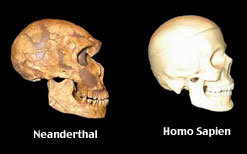Archaeologists have discovered many extinct species that physically resemble us. They are known asHominins: a member of the human lineage, more closely related to living people than to chimpanzees or other living primates.
The last Hominin to go extinct was the Neanderthal. They arose about 250,000 years ago (vs. humans who appeared 200,000 years ago) and went extinct about 30,000 years ago. Were these hominins human?
According to the Bible, no! The sources clearly tell us that we have unique features, most of all the ability to use language and symbolic thought, usually expressed in the sources as “understanding”.
He [God] created him [Adam] with four attributes of the higher beings [angels]and four attributes of the lower beings [animals]. [The four attributes of] the higher beings are: …; he speaks, like the ministering angels; he understands, like the ministering angels; … He [Adam] has four attributes of the lower beings: he eats and drinks, like an animal; procreates, like an animal; excretes, like an animal; and dies, like an animal…..[i]
What does science say about us vs. Neanderthals or for that matter all prior hominins? While still under dispute, the answer is coming out in agreement with the Bible. Here is the latest from the New Scientist magazine:[ii]
The single greatest difference between Neanderthals and humans that we can see in the archaeological record, however, lies in both the quantity and nature of the artifacts they imbued with an obvious symbolic dimension.
Humans today live in what we call a symbolic culture. All the objects around us have a symbolic dimension. The clothes we wear, for instance, send out signals about us that are unrelated to their practical function. We form symbolic relationships where no biological relationship exists, with a husband, sister-in-law, godchild, blood-brother, for example. Language, of course, is another key example, the relationship between the words and the objects and concepts to which they refer is completely arbitrary and that is the essence of a symbol. Neanderthal’s created few symbolic artifacts… but these artifacts pale next to the record of symbolic material culture created by early humans.
This subject is explored in further detail within the book, The Broken Gift: How did we get here?.

